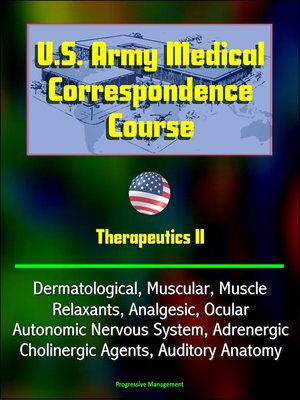U.S. Army Medical Correspondence Course
ebook ∣ Therapeutics II--Dermatological, Muscular, Muscle Relaxants, Analgesic, Ocular, Autonomic Nervous System, Adrenergic, Cholinergic Agents, Auditory Anatomy

Sign up to save your library
With an OverDrive account, you can save your favorite libraries for at-a-glance information about availability. Find out more about OverDrive accounts.
Find this title in Libby, the library reading app by OverDrive.



Search for a digital library with this title
Title found at these libraries:
| Library Name | Distance |
|---|---|
| Loading... |
Subcourse MD0805, Therapeutics II, is intended to give you a review of certain essential anatomical and physiological concepts important to pharmacology and to introduce six categories of drugs. The review of anatomy and physiology should help you gain a better understanding of how the drugs work in the body and how they produce the side effects that are commonly associated with their use.This subcourse is approved for resident and correspondence course instruction. It reflects the current thought of the Academy of Health Sciences and conforms to printed Department of the Army doctrine as closely as currently possible.CHAPTER 1 - DERMATOLOGICAL AGENTS * Section I. Background Information * Section II. Therapeutic Categories of Dermatological Agents * Exercises * CHAPTER 2 - THE HUMAN MUSCULAR SYSTEM * Exercises * CHAPTER 3 - SKELETAL MUSCLE RELAXANTS * Section I. General * Section II. The Neuromuscular Blocking Agents * Section III. Centrally Acting Skeletal Muscle Relaxants * Exercises * CHAPTER 4 - ANALGESIC, ANTI-INFLAMMATORY, AND ANTIGOUT AGENTS * Section I. Background * Section II. Analgesic Agents * Section III. Anti-inflammatory Agents * Section IV. Antigout Agents * Exercises * CHAPTER 5 - REVIEW OF OCULAR AND AUDITORY ANATOMY AND PHYSIOLOGY * Section I. Ocular Anatomy and Physiology * Section II. Auditory Anatomy and Physiology * Section III. Anatomy and Physiology of Equilibrium (Balance) * Exercises * CHAPTER 6 - REVIEW OF THE AUTONOMIC NERVOUS SYSTEM * Section I. Introduction * Section II. The Autonomic Nervous System * Section III. The Sympathetic Nervous System * Section IV. The Parasympathetic Nervous System * Exercises * CHAPTER 7 - ADRENERGIC AGENTS * Exercises * CHAPTER 8 - ADRENERGIC BLOCKING AGENTS * Exercises * CHAPTER 9 - CHOLINERGIC AGENTS * Exercises * CHAPTER 10 - CHOLINERGIC BLOCKING AGENTS (ANTICHOLINERGIC AGENTS) * Exercises







